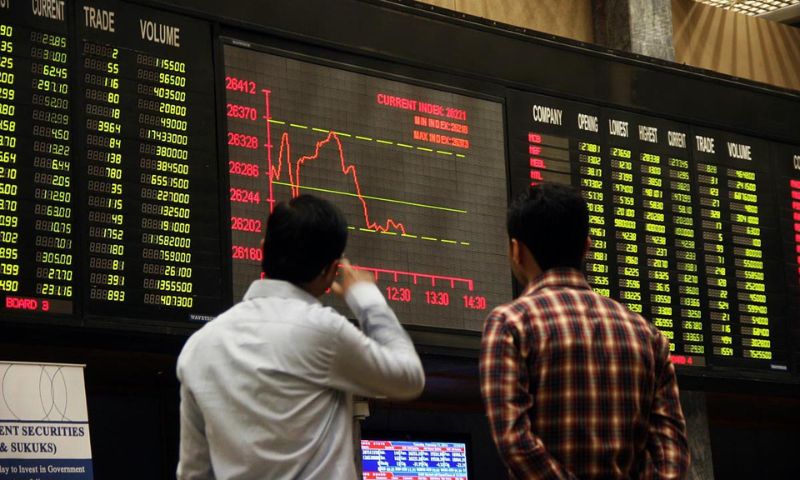ISLAMABAD: The Pakistan Stock Exchange (PSX) observed a volatile session on Monday, with the benchmark KSE-100 Index shedding over 600 points amid selling pressure.
The market opened on a strong note, with the KSE-100 Index climbing to an intra-day high of 150,079.75.
However, profit-taking resorted to the stock market, pushing the index down to an intra-day low of 148,757.13.
By the close of trading, the benchmark index had settled at 148,815.30, marking a decline of 677.75 points, or 0.45%.
Analysts attributed the downturn to profit-taking activity amid the onset of rollover week.
Selling pressure was observed in key sectors, including automobile assemblers, commercial banks, oil and gas exploration companies, and OMCs. Index-heavy stocks, including HUBO, MARI, OGDC, POL, PPL, SNGPL, SSGC, and WAFI, traded in the red.
On Monday, a total of 693,301,556 shares were traded as compared to 799,868,015 shares on the last working day, whereas the price of shares stood at PKR 26.343 billion against PKR 40.372 billion on the previous trading day.
As many as 479 companies transacted their shares in the stock market, 204 of them recorded gains and 246 met losses, whereas the share price of 29 companies remained unchanged.
The market showed strong performance during the previous week, buoyed by robust corporate earnings and active investor participation.
The KSE-100 Index touched an intraday high of 151,262 points before closing at 149,493, posting a weekly gain of 3,001 points or 2% on a week-on-week basis.
Global market trend
On the global front, Asian stock markets moved higher on Monday, as investors reacted positively to growing expectations of US interest rate cuts. Hopes are also pinned on Nvidia’s upcoming earnings report, which investors believe could support the continued high valuations in the AI sector.
Federal Reserve Chair Jerome Powell’s dovish tone has prompted markets to price in an 84% probability of a 25-basis-point rate cut in September, with projections of up to 100 basis points in total easing by mid-2026, bringing rates down to 3.25–3.5%.
This shift has led to a drop in US Treasury yields and the dollar, improving the earnings outlook but also signaling potential economic and employment concerns.
Investor optimism will face a key test later this week with the release of US personal consumption expenditure (PCE) data. Core inflation is expected to tick up to 2.9%, the highest since late 2023.
Any surprise to the upside could dampen the rally in long-term US Treasuries, particularly as the market prepares for $183 billion in new debt issuance.
For now, global markets are following Wall Street’s lead. Japan’s Nikkei gained 0.6%, South Korea’s index rose 0.7%, and Australia’s advanced 0.4%.
MSCI’s broadest index of Asia-Pacific shares outside Japan added 1.1%, with Chinese blue chips climbing another 1.0%.
The Chinese market has now risen nearly 9% this month, approaching levels not seen since mid-2022.
Back home, the Pakistani rupee posted a marginal gain against the US dollar in the interbank market, appreciating by Re0.03 to close at 281.87 on Monday. This marks the rupee’s twelfth consecutive gain against the greenback.



























